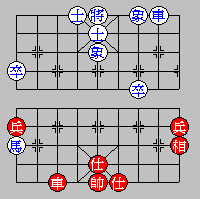21. A Knight cannot perpetually chase a Rook, regardless of whether
the Rook is protected, if the Rook only counter attacks in one of
its moves. (See examples in Diagram 45, 46, and 47)
 Diagram 45: Red (in Capital) moves first
Diagram 45: Red (in Capital) moves first
N4+3 r5-1
N3+4 r5+1
N4-3 r5-1
N3-4 r5-1
N4+3 ....
Explanation:
The Red Knight is perpetually chasing the Black Rook while the Black
Rook is doing "one chase and one idle". Red has to change.
 Diagram 46: Red (in Capital) moves first
Diagram 46: Red (in Capital) moves first
R7+2 n1+2
R7-1 n2-1
R7+1 n1+2
R7-1 N2-1
R7+1 n1+2
.
.
 Diagram 47: Red (in Capital) moves first
Diagram 47: Red (in Capital) moves first
N1+3 r87
N3-1 r78
N1+3 r87
N3-1 r78
N1+3 ...
Explanation:
In Diagrams 46 and 47, the situation is called "Two chases and
one chase back". The Knight is doing the "two chases" and the
Rook is doing the "one chase back". Although the Knight is forced
to do the "two chases", it still violates the rule and has to
change.




